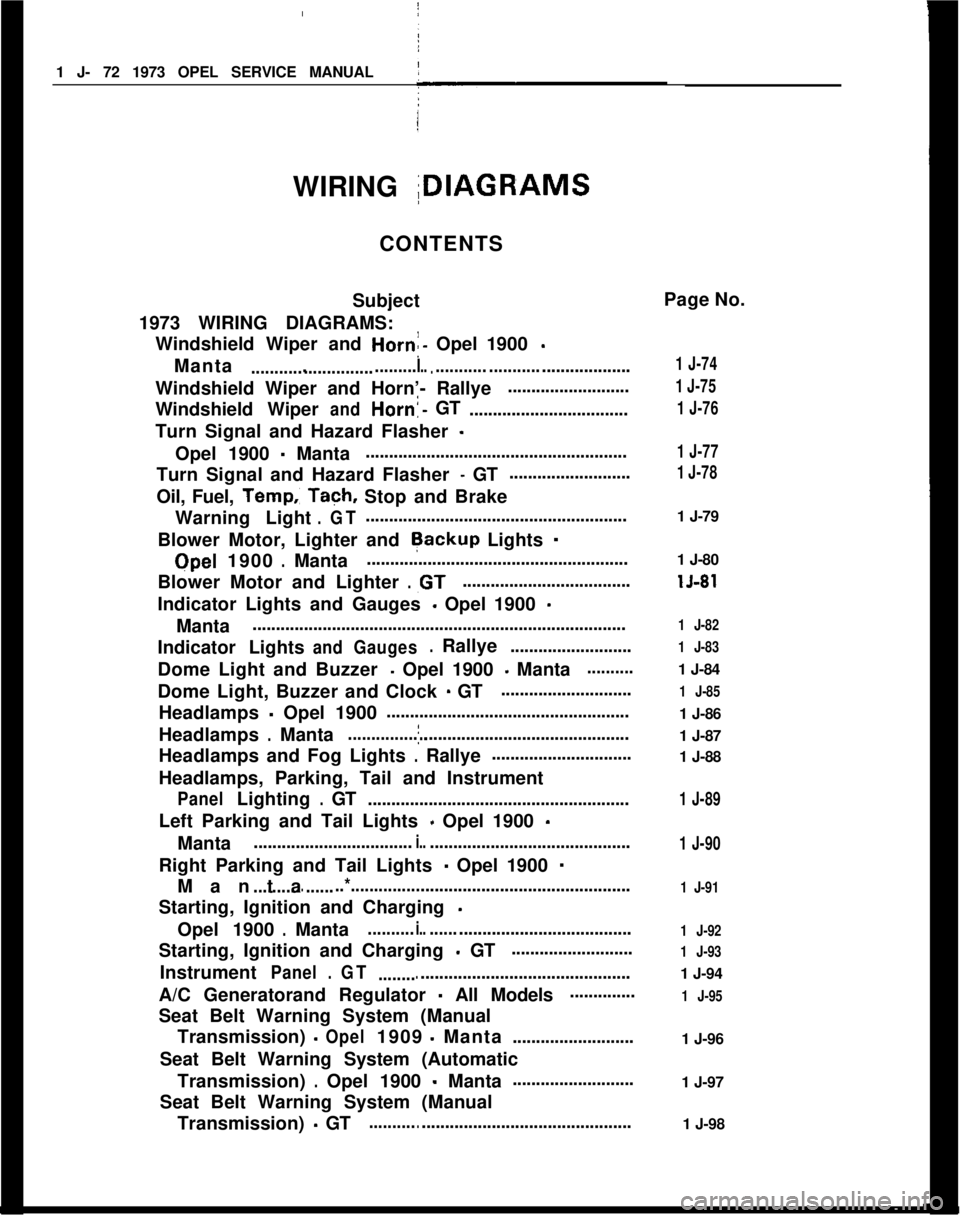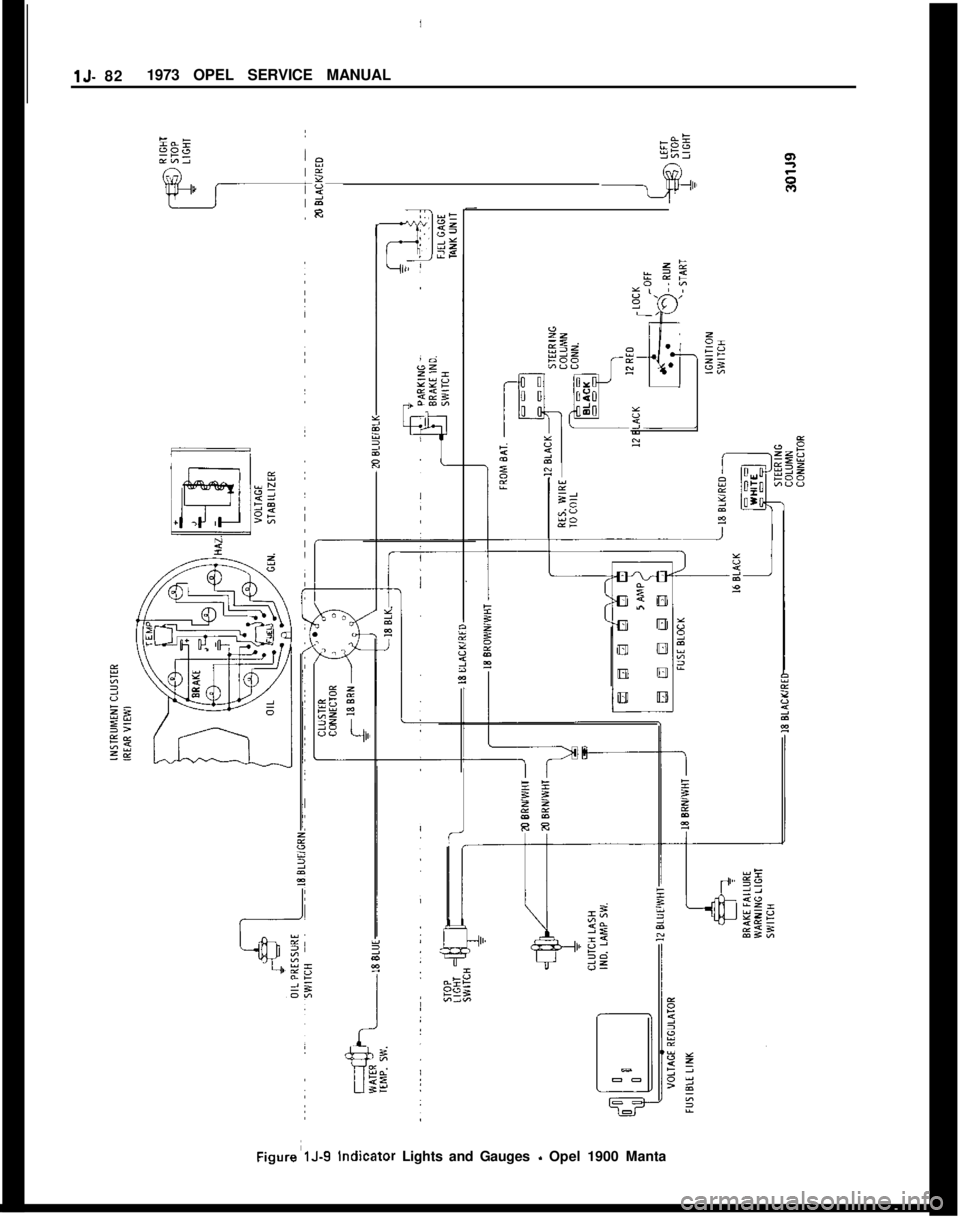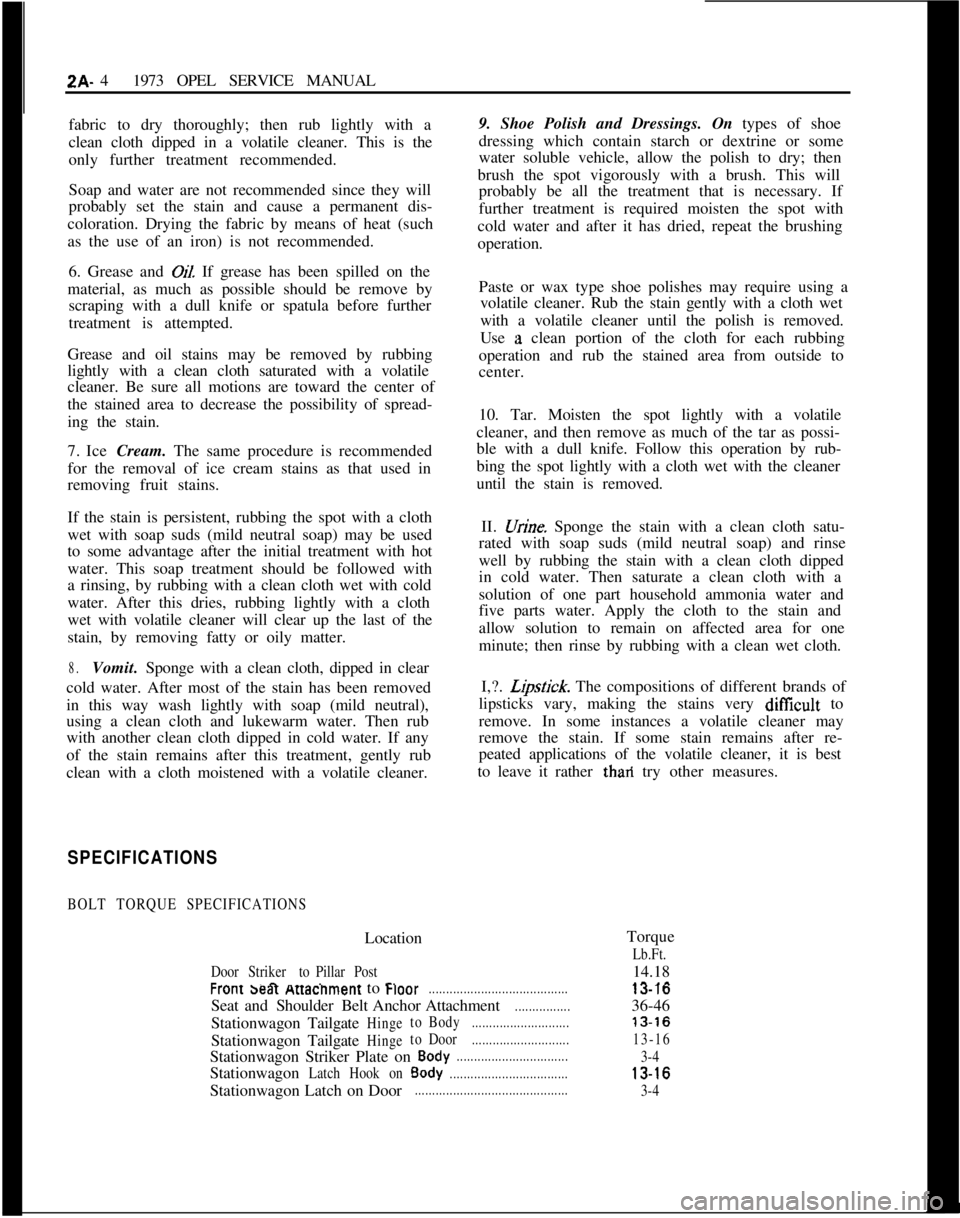light OPEL GT-R 1973 Workshop Manual
[x] Cancel search | Manufacturer: OPEL, Model Year: 1973, Model line: GT-R, Model: OPEL GT-R 1973Pages: 625, PDF Size: 17.22 MB
Page 93 of 625

1 J- 72 1973 OPEL SERVICE MANUAL
I
WIRING IDIAGRAMS
CONTENTS
Subject
1973 WIRING DIAGRAMS: Windshield Wiper and
Horn:- Opel 1900 -
Manta....................................I.............. ..............................
Windshield Wiper and Horn’- Rallye ..........................
Windshield Wiper
andHorn!-GT
..................................
Turn Signal and Hazard Flasher
-
Opel 1900 - Manta !
........................................................
Turn Signal and Hazard Flasher
- GT ..........................
Oil, Fuel,
Temp.: Tach, Stop and Brake
Warning Light
.GT........................................................
Blower Motor, Lighter and
Rackup Lights -
Qpel 1900.Manta ........................................................
Blower Motor and Lighter
.,GT....................................
Indicator Lights and Gauges
- Opel 1900 -
Manta ........................................................................\
........
Indicator Lights
andGauges.Rallye ..........................
Dome Light and Buzzer
- Opel 1900 - Manta..........
Dome Light, Buzzer and Clock - GT ............................
Headlamps
- Opel 1900 ’
....................................................
Headlamps
.Mantaj............................................................
Headlamps and Fog Lights
.Rallye ..............................
Headlamps, Parking, Tail and Instrument
PanelLighting.GT ........................................................
Left Parking and Tail Lights
- Opel 1900 -
Manta ..................................i.............................................
Right Parking and Tail Lights
- Opel 1900 -
Manta................. ..*............................................................
Starting, Ignition and Charging
-
Opel 1900.Manta..........i.............................................
Starting, Ignition and Charging
- GT ..........................
Instrument
Panel.GT ......................................................
A/C Generatorand Regulator
- All Models..............
Seat Belt Warning System (Manual Transmission)
-Opel1909-Manta ..........................
Seat Belt Warning System (Automatic Transmission)
.Opel 1900 - Manta..........................
Seat Belt Warning System (Manual Transmission)
- GT........................................................ Page No.
1 J-74
1 J-75
1 J-76
1 J-77
1 J-78
1 J-79
1 J-80
lJ-81
1 J-82
1 J-83
1 J-84
1 J-85
1 J-86
1 J-87
1 J-88
1 J-89
1 J-90
1 J-91
1 J-92
1 J-93
1 J-94
1 J-95
1 J-96
1 J-97
1 J-98
Page 100 of 625

I
WIRING DIAGRAMS15.79
IIFigure lJ-6
Oil. Fuel. Temp. Tach, Stop and Brake Warning Light. GT
I
Page 102 of 625

I
WIRING DIAGRAMSlJ- 81r
Figure 1 J-8 Blower and Lighter
- GT
Page 103 of 625

I
IlJ- 821973 OPEL SERVICE MANUALFigure’lJ-9 indicator Lights and Gauges
- Opel 1900 Manta
Page 104 of 625

I
IWIRING DIAGRAMSIJ-83I
Figure 1 J-10 Indicator Lights and Gauges
- Ratlye
Page 105 of 625

r
2UREDp
IM
BRNIWHI
BUZZER
3 CLOSED POSlTlONl
/-
14 RED - TO STEERING
COLUMN CONN.
20 RED
12 RED FROM BATTERY--18 GRAY--12 RED
-I
J
DOME LIGHT
&SWITCH1
1
.,_ &,,,.~~
STEER I NG
COLUMN
CONNECTORTRUNK LIGHT?&SWITCH
IGNITION
SWITCH‘\BUZZER SWITCH(HELD CLOSED WITH
KEY IN “OFF” & “LOCK”POSITION1
3OlJll
Page 109 of 625

1 J- 88 1973 OPEL SERVICE MANUAL
!
I1.
Figure lJ-15’Headlamp and Fog Lights - Rallye
Page 112 of 625

WIRING DIAGRAMSlJ- 91
RFigure
lJ-18 Right Parking, Tail and Instrument Panel Lighting -Opel 1900. Manta
Page 126 of 625

GENERAL INFORMATIONZA- 3
ded with rubber, and volatile cleaners are generally
solvents for rubber. The application of too much
cleaner may destroy these rubber pads. Do not use
volatile cleaners on vinyl coated fabrics.
Procedure For Cleaning
Vinyl Fabrics With Synthetic Detergents
1. Make a solution of the synthetic detergent in luke-
warm water, working up a thick, frothy suds.
2. With a clean cloth or sponge, dampened with
lukewarm water, apply suds only to the surface of the
upholstery using light to medium pressure, repeating
several times, applying more suds with a clean por-
tion of the cloth or sponge.
3. With a second clean cloth, dampened with luke-
warm water, rub over the area with medium pressure
to remove excess detergent and loose material.
4. With a clean dry cloth, wipe off all excess mois-
ture. A vacuum cleaner may also be used.
5. Allow the upholstery to dry partially; then repeat
the above treatment if necessary to remove stain.
6. When the upholstery is satisfactorily cleaned, al-
low to dry completely before using.
Instructions for the Removal of
Specific Stains From Automotive
Upholstery Materials
Some types of stains and soilage, including blood,
ink, chewing gum, etc., require special consideration
for satisfactory results. For thkse, and other stains,
specific instructions are outlined in succeeding para-
graphs. It must be expected, particularly where wa-
ter treatment is specified, that discoloration and
finish disturbance may occur. In some cases fabric
disturbance may be considered preferable to the stain
itself. By following the procedures outlined below,
reasonably satisfactory results can be expected.
1. Bafrery Acids. Apply ordinary household am-
monia water with a brush or cloth to the affected
‘area, saturating it thoroughly. Permit the ammonia
water to remain on the spot about a minute, so that
it will have ample time to neutralize the acid. Then
rinse the spot by rubbing with a clean cloth saturated
with cold water.
This treatment will suffice for both old and new
stains. However, no type of treatment will repairdamage.to fibers resulting from the actidn of the
acids on the fibers particularly after the spot has
dried.
2.
Blood. Do not use hot water or soap and wateron blood stains since they will set the stain, thereby
making its removal practically impossible.
Rub the stain with a clean cloth saturated with cold
water until no more of the stain will come out. Care
must be taken so that clean portions ofcloth are used
for rubbing the stain.
This treatment should remove all of the stain. If it
does not, apply a small amount of household am-
monia water to the stain with a cloth or brush. After
a lapse of about one minute, continue to rub the stain
with a clean cloth dipped in clear cold water.
If the stain remains after the use of water and am-
monia, a thick paste of corn starch and cold water
may be applied to the stained area. Allow the paste
to remain until it has dried and absorbed the stain.
Then pick off the dry starch. Brush the surface to
remove starch particles that remain. For heavy
stains, several applications of starch paste may be
necessary.3. Candy. Candy stains, other than candy contain-
ing chocolate, can be removed by rubbing the af-
fected area with a cloth soaked with very hot water.
If the stain is not completely removed, rub area
lightly (after drying) with a cloth wet with a volatile
cleaner. This will usually remove the stain.
Candy stains resulting from cream and fruit-filled
chocolates can be removed more easily by rubbing
with a cloth soaked in lukewarm soap-suds (mild
neutral soap) and scraping, while wet, with a dull
knife. This treatment is followed with a rinsing by
rubbing the spot with a cloth dipped in cold water.
Stains resulting from chocolate or milk chocolate can
be removed by rubbing the stain with a cloth wet
with lukewarm water. After the spot is dry, rub it
lightly with a cloth dipped in a volatile cleaner.
4. Chewing Gum. Harden the gum with an ice cube,
and scrape off particles with a dull knife. If gum
cannot be removed completely by this method, mois-
ten it with a volatile cleaner and work it from the
fabric with a dull knife, while gum is still moist.
5. Fruit, Fruit Stains, Liquor and Wine. Practicallyall fruit stains can be removed by treatment with very
hot water. Wet the stain well by applying hot water
to the spot with a clean cloth. Scrape all excess pulp,
if present, off the fabric with a dull knife; then rub
vigorously with a cloth wet with very hot water. If
the stain is very old or deep, it may be necessary to
pour very hot water directly on the spot, following
this treatment with the scraping and rubbing. Direct
application of hot water to fabrics is not recom-
mended for general use since discoloration usually
results.
If the above treatments do not remove stain, allow
Page 127 of 625

fabric to dry thoroughly; then rub lightly with a
clean cloth dipped in a volatile cleaner. This is the
only further treatment recommended.
Soap and water are not recommended since they will
probably set the stain and cause a permanent dis-
coloration. Drying the fabric by means of heat (such
as the use of an iron) is not recommended.
6. Grease and 02 If grease has been spilled on the
material, as much as possible should be remove by
scraping with a dull knife or spatula before further
treatment is attempted.
Grease and oil stains may be removed by rubbing
lightly with a clean cloth saturated with a volatile
cleaner. Be sure all motions are toward the center of
the stained area to decrease the possibility of spread-
ing the stain.
7. Ice Cream. The same procedure is recommended
for the removal of ice cream stains as that used in
removing fruit stains.
If the stain is persistent, rubbing the spot with a cloth
wet with soap suds (mild neutral soap) may be used
to some advantage after the initial treatment with hot
water. This soap treatment should be followed with
a rinsing, by rubbing with a clean cloth wet with cold
water. After this dries, rubbing lightly with a cloth
wet with volatile cleaner will clear up the last of the
stain, by removing fatty or oily matter.
8.Vomit. Sponge with a clean cloth, dipped in clear
cold water. After most of the stain has been removed
in this way wash lightly with soap (mild neutral),
using a clean cloth and lukewarm water. Then rub
with another clean cloth dipped in cold water. If any
of the stain remains after this treatment, gently rub
clean with a cloth moistened with a volatile cleaner.
SPECIFICATIONS
BOLT TORQUE SPECIFICATIONSLocation
DoorStriker toPillarPostr .^ ...r.ZA- 41973 OPEL SERVICE MANUAL
9. Shoe Polish and Dressings. On types of shoe
dressing which contain starch or dextrine or some
water soluble vehicle, allow the polish to dry; then
brush the spot vigorously with a brush. This will
probably be all the treatment that is necessary. If
further treatment is required moisten the spot with
cold water and after it has dried, repeat the brushing
operation.
Paste or wax type shoe polishes may require using a
volatile cleaner. Rub the stain gently with a cloth wet
with a volatile cleaner until the polish is removed.
Use
;a clean portion of the cloth for each rubbing
operation and rub the stained area from outside to
center.
10. Tar. Moisten the spot lightly with a volatile
cleaner, and then remove as much of the tar as possi-
ble with a dull knife. Follow this operation by rub-
bing the spot lightly with a cloth wet with the cleaner
until the stain is removed.
II. .X&e. Sponge the stain with a clean cloth satu-
rated with soap suds (mild neutral soap) and rinse
well by rubbing the stain with a clean cloth dipped
in cold water. Then saturate a clean cloth with a
solution of one part household ammonia water and
five parts water. Apply the cloth to the stain and
allow solution to remain on affected area for one
minute; then rinse by rubbing with a clean wet cloth.
I,?.
L,ipslick. The compositions of different brands of
lipsticks vary, making the stains very
diff%cult to
remove. In some instances a volatile cleaner may
remove the stain. If some stain remains after re-
peated applications of the volatile cleaner, it is best
to leave it rather thari try other measures.
Torque
Lb.Ft.
wont saar twacnment to war........................................Seat andShoulderBelt Anchor Attachment
................StationwagonTailgate
HingetoBody............................StationwagonTailgate
HingetoDoor............................Stationwagon Striker Plate on
Body................................Stationwagon
LatchHookonBody..................................Stationwagon Latch on Door
............................................14.18
_^ _^13-1036-46
13-16
13-16
3-4
13-16
3-4